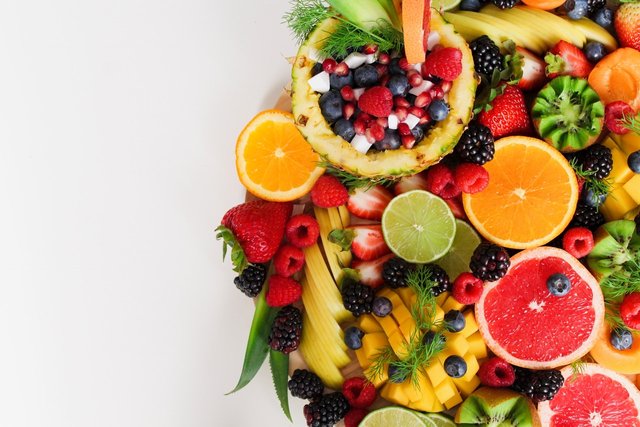
First of all, by "kind of superhuman," I mean, for example:
being able to fight off diseases like cancer
having slower-aging cells
having clean digestion, including odorless farts
having practically no body odor
having more energy and mental clarity.
Now, most of us have obviously been told that we're designed to eat both plant and animal foods. But, when you really take a look at the human body, it is quite easy to see that it closely resembles the body of a frugivore (an animal that's designed to eat a diet largely based on fruit).
Case in point: unlike carnivores, we lack stomach acid that's strong enough to kill potentially harmful bacteria like E. coli, which is why we generally "cheat" by cooking meat before we eat it. We also lack things like claws and big mouths filled with fangs. After all, our primate ancestors are supposed to have been frugivores/herbivores, and even our human ancestors seem to have eaten a largely plant-based diet:
It reportedly wasn't until around 7500 years ago that people living in central Europe began to regularly drink non-human milk. And, since most people don't originate from there, most don't continue to produce the enzyme lactase after infancy, which is needed to digest the lactose milk contains. Around 75 percent of adults worldwide (mostly non-Caucasians) are lactose intolerant.
As for eggs, there are good reasons why corporations are not allowed to advertise them as healthy, nutritious, or even safe if they want to finance their ads with money from the American Egg Board:
Even grains are off the table. And so are legumes, except for a few that are technically edible raw. Generally, though, I think it's safe to say that neither legumes nor grains are part of our species-specific diet. For starters, they are rock-hard, and therefore need to be processed to become edible. They're also full of raw starch (of which we can only unproblematically digest so much). On top of that, they contain so-called antinutrients. Depending on the type, legumes can even contain significant amounts of outright toxic substances, like cyanide and certain lectins.

While cooking does reduce/neutralize many of the problem-causing substances found in raw grains and legumes, it also reduces their nutrient content. Plus, at high temperatures, the cooking of grains, legumes, and potatoes creates, for example, acrylamide.
Regular potatoes are full of raw starch too, and the peels contain not-so-small amounts of the glycoalkaloids solanine and chaconine, which are not only toxic but also barely heat-sensitive. (You really don't want to eat green potatoes.)
There's also the potato lectin, but it's a lot less harmful, and only around 40-50 percent of its biological activity is retained after cooking.
What's there left to eat then? Well, lots of fruits, vegetables, nuts, and seeds.
However, while the types of nuts and seeds we're used to eating can also be eaten raw, they're still a lot more difficult to digest than fruits and vegetables, partly because they, too, contain antinutrients. Fortunately, like with grains and legumes, soaking and sprouting them helps.
Again, I'm only talking about the nuts and seeds we're used to eating. If you weigh 70 kg (≈154 lb), and you swallow 200 finely chewed apple seeds (≈20 apple cores), you could die from cyanide poisoning. Then again, as tempting as it may be, eating 1.08 kg (≈2.38 lb) of almonds is also not a very good idea.
Of course, the thought of eating nothing but raw fruits, vegetables, and maybe some nuts and seeds is pretty tempting too, especially when you don't know of a single tasty fruitarian recipe. But I think going through withdrawal for a few weeks to come out kind of superhuman is worth it.
Update
If an academic paper I refer to has been put behind a paywall, it may still be available for free on Sci-Hub (whose domain name may change someday).
1. Disease Prevention & Treatment
In 2015, the World Health Organization added red meat to the list of Group 2A carcinogens, which are "probably carcinogenic to humans." It also added processed meat to the list of Group 1 carcinogens, which are deemed cancer-causing. This was done after the International Agency for Research on Cancer reviewed more than 800 studies that deal with processed and/or red meat.
"Red meat refers to all types of mammalian muscle meat, such as beef, veal, pork, lamb, mutton, horse, and goat.
Processed meat refers to meat that has been transformed through salting, curing, fermentation, smoking, or other processes to enhance flavour or improve preservation. Most processed meats contain pork or beef, but processed meats may also contain other red meats, poultry, offal, or meat by-products such as blood.
Examples of processed meat include hotdogs (frankfurters), ham, sausages, corned beef, and biltong or beef jerky as well as canned meat and meat-based preparations and sauces."
To be clear, the agency's meta-analysis only really dealt with colorectal cancer. There's plenty of peer-reviewed scientific literature pointing out that the consumption of processed meat can also cause other types of cancer, as well as, for example, diabetes and heart disease. After all, meat contains, among other things, cholesterol, hormones, antibiotics (generally less or none if organic), as well as dioxins. And that goes for fish, dairy, and eggs too.
Obviously, animal foods also contain nutrients that we need to be healthy, but none of them are only found in animal foods, and yes, that includes vitamin B12.
Neither animals nor plants produce vitamin B12, bacteria do. And, if the vitamin is present in the soil, it is then absorbed by at least certain plants. That, however, doesn't happen often these days, thanks to soil depletion. Good thing, then, that we can simply take a supplement.
Here's what the world's largest organization of food and nutrition professionals says about vegan diets:
"It is the position of the Academy of Nutrition and Dietetics that appropriately planned vegetarian, including vegan, diets are healthful, nutritionally adequate, and may provide health benefits for the prevention and treatment of certain diseases. These diets are appropriate for all stages of the life cycle, including pregnancy, lactation, infancy, childhood, adolescence, older adulthood, and for athletes."

2. Cellular Aging
As we age, the telomeres protecting our DNA get shorter, which eventually leads to our cells dying/no longer dividing. Since the enzyme telomerase slows the shortening, a study was done to find out whether lifestyle improvements increase the enzyme's activity in our body.
The participants, in addition to exercising more often, ate a "low-fat (10% of calories from fat), whole foods, plant-based diet high in fruits, vegetables, unrefined grains, legumes, and low in refined carbohydrates." The study's conclusion:
"Comprehensive lifestyle changes significantly increase telomerase activity and consequently telomere maintenance capacity in human immune-system cells. Given this finding and the pilot nature of this study, we report these increases in telomerase activity as a significant association rather than inferring causation. Larger randomised controlled trials are warranted to confirm the findings of this study."
Five years later, in 2013, another study showed that eating a healthier diet significantly increases telomerase activity:
Aside from avoiding the saturated fat found in animal foods, eating a diet rich in antioxidants helps protect our telomeres. That's because antioxidants neutralize so-called free radicals, which, in a process called oxidative stress, shorten our telomeres.
While antioxidants are barely present in animal foods, they are readily available in plant foods.
There's a catch, though. Antioxidants are generally heat-sensitive, which explains why this study from 1995 found that 'the "living food diet" provides significantly more dietary antioxidants than does the cooked, omnivorous diet.' (They call it the "living food diet" because cooked nuts and seeds may not germinate when you plant them. Enzymes, like other proteins, start to denature at temperatures above 104 degrees Fahrenheit/40 degrees Celsius.)
Another thing worth mentioning is that some antioxidants, including beta-carotene, are fat-soluble, so they're ideally eaten with a little fat:
Update
Even when you do eat a beta-carotene-rich meal that contains less than 3 g (≈0.1 oz) of fat, much of the beta-carotene can be stored in your intestinal absorptive cells until the next meal or so.
Another way eating less animal foods helps fight the aging process:
3. Digestion
Since plant foods, unlike animal foods, contain fiber, and insoluble fiber speeds up digestion, bacteria in the large intestine don't have as much time to do their dirty business when you're eating a plant-based diet.
There are still very few studies about fruitarian diets, but, in addition to this study, which concludes "the gut microbiome can rapidly respond to altered diet," and this study, which concludes "[t]he vegan gut profile appears to be unique in several characteristics, including a reduced abundance of pathobionts and a greater abundance of protective species," there's also this study:
"Eighteen volunteers were divided randomly into two groups. The test group received an uncooked vegan diet for 1 month and a conventional diet of mixed Western type for the other month of the study. The control group consumed a conventional diet throughout the study period. Stool samples were collected. Bacterial cellular fatty acids were extracted directly from the stool samples and measured by GLC. Computerized analysis of the resulting fatty acid profiles was performed. Such a profile represents all bacterial cellular fatty acids in a sample and thus reflects its microflora and can be used to detect changes, differences, or similarities of bacterial flora between individual samples or sample groups. GLC profiles changed significantly in the test group after the induction and discontinuation of the vegan diet but not in the control group at any time, whereas quantitative bacterial culture did not detect any significant change in fecal bacteriology in either of the groups. The results suggest that an uncooked extreme vegan diet alters the fecal bacterial flora significantly when it is measured by direct stool sample GLC of bacterial fatty acids."
There's also the fact that around 99 percent of a smelly fart already consists of odorless gases. The two main things to blame for the smell are the composition of the food that's currently being digested and the amount of time it has been digested for.
Case in point: food high in sulfur. Bacteria in the large intestine turn sulfur into sulfurous gases, mainly into the "rotten egg gas" hydrogen sulfide, which makes up around one percent of a smelly fart.
Sulfur-rich foods include animal foods, legumes, grains, nuts, spinach, dried fruits that had sulfur dioxide added as a preservative, and Brassica/Allium vegetables (cabbage, broccoli, cauliflower, Brussels sprouts, bok choy / onions, shallots, garlic, leeks).
Likewise, the urine of people who eat a fruitarian diet is usually relatively clear and non-smelly, which I assume has much to do with the high water content of fruits and vegetables.
4. Body Odor
"Axillary body odor is individually specific and potentially a rich source of information about its producer. Odor individuality partly results from genetic individuality, but the influence of ecological factors such as eating habits are another main source of odor variability. However, we know very little about how particular dietary components shape our body odor."
That was from one of the two studies I could find that deal with diet-related body odor. In it, women judged the axillary body odor of men before and after they didn't eat meat for two weeks.
"Results of repeated measures analysis of variance showed that the odor of donors when on the nonmeat diet was judged as significantly more attractive, more pleasant, and less intense."
5. Energy & Mental Clarity
When I switched from a vegan diet to a fruitarian diet, I didn't just notice a decent improvement in energy levels. The difference was so big that, when I took a break from eating fruitarian, I also took a break from, for example, watching my favorite shows, since I didn't want to watch them without being "fully there."
Moreover, when I went for a run a couple of weeks after I went fruitarian, instead of being able to somewhat "comfortably" run for around an hour, I comfortably ran for two hours straight and only stopped due to my muscles complaining that they're not used to this.
As unbelievable as that may seem, I can explain, at least to some extent, how that happened.
All living cells in the human body use sugar and oxygen (when available) to produce ATP, which is the energy currency they run on. And, when you eat a diet low in saturated fat, your cells can absorb sugar a lot easier:
There's also this:
And this:
While I didn't drink any beet juice in the weeks before I went for said run, I did eat a clean, easy-to-digest, nutrient-packed diet.

Now, since I wrote "for example" at the beginning, here are five more benefits of eating a fruitarian diet:
6. Eating a Low-Fat Vegan Diet Can Cure Diet-Related Erectile Dysfunction
7. Eating a High-Carb Vegan Diet Can Make Losing Weight Effortless
A proper high-carb vegan diet is not only growth hormone-free, low in fat, and high in fiber but also low in salt, which, due to its dehydrating effect, can cause the body to hold in multiple liters of water.
Fortunately, when you consume less salt, you not only lose water weight but also get used to the taste of low-salt food:
Eating a high-carb vegan diet instead of a calorie-restrictive omnivorous one also works better when it comes to losing weight because it provides the body with enough fuel to run properly. As in, the body won't go into "famine mode," in which it slows the metabolism and stores fat much more aggressively.
In my case, however, eating a predominantly fruitarian diet allowed me to finally gain enough weight. I was underweight for years, even though I ate more than the average man, and despite the fact that my blood tests were fine.
8. Eating a Fruitarian Diet Can Make Your Sexual Fluids Taste a Lot Better


It may be a good idea, though, to avoid certain spices and vegetables. The day after I ate a meal containing ginger and leek, a friend told me that my cum now tastes quite bad, he said there was a night-and-day difference.

9. A Vegan Diet Rich in Raw Fruits and Vegetables May Be a Cure for Chemically Caused Depression
(Other possible depression cures are psylocibe mushrooms and ayahuasca.)
10. Eating a Low-Fat Vegan Diet Can Make Your Skin Look Clear and Radiant
A few weeks after I started eating fruitarian, my still-minor wrinkles almost completely disappeared. They then reappeared when I stopped eating fruitarian.
How to Go Vegan
How to Go Fruitarian
What to Eat
Many fruitarians, myself included, eat lots of ripe bananas. Out of all the fresh fruits typically sold, they are usually the cheapest source of calories and other nutrients:

While bananas are relatively low in beta-carotene, vitamin K, sodium, calcium, iron, and omega-3 fatty acids, leaf vegetables are generally high in these nutrients, meaning bananas and leaf vegetables go very well together (especially in the form of sweet green smoothies).
However, spinach, purslane, garden orache, rhubarb, beet leaves, and sorrel are also high in the antinutrient oxalate, which negatively affects calcium and iron absorption.
To die from radiation poisoning, you'd have to eat around 10 million bananas at once. And, to die from potassium poisoning (hyperkalemia), you'd have to eat around 42 to 480 bananas at once. Then again, as unrealistic as the those amounts are already, they should still be far too low to actually cause fatal hyperkalemia. After all, eating 42 bananas "at once" isn't the same as eating 18 g (≈0.64 oz) of potassium at once, since bananas contain a lot of water, among other things. This gives your kidneys time to eliminate excess potassium in the urine. In fact, there's no evidence that high potassium intakes from food cause hyperkalemia in adults with normal kidney function.
But, to be clear:
"[I]n people with impaired urinary potassium excretion due to chronic kidney disease or the use of certain medications, such as angiotensin converting enzyme (ACE) inhibitors or potassium-sparing diuretics, even dietary potassium intakes below the [adequate intake] can cause hyperkalemia [11]. Hyperkalemia can also occur in people with type 1 diabetes, congestive heart failure, adrenal insufficiency, or liver disease [7]. Individuals at risk of hyperkalemia should consult a physician or registered dietitian about appropriate potassium intakes from all sources. Information on low-potassium diets is also available from the National Kidney Disease Education Program." - The Office of Dietary Supplements
"Hyperkalemia can be classified according to serum potassium into mild (5.5–6.5 mmol/l), moderate (6.5–7.5 mmol/l) and severe (>7.5 mmol/l) hyperkalemia.
Hyperkalemia is rarely associated with symptoms, occasionally patients complain of palpitations, nausea, muscle pain, or paresthesia. However, moderate and especially severe hyperkalemia can lead to disturbances of cardiac rhythm, which can be fatal [28, 29]." - Anja Lehnhardt and Markus J. Kemper
The two quotes above demonstrate why, when you have certain medical conditions, it may be helpful to consult your physician before making big diet changes. However, while physicians may know which nutrients to be mindful of when you have, for example, kidney disease, they usually aren't very knowledgeable when it comes to nutrition in general:
Getting tested for food allergies before trying new fruits, vegetables, nuts, or seeds may be a good idea too.
"It is outrageous that the governments of the US and Britain require a prescription for EpiPens, (adrenalin), though the government of Canada--sensibly--does not.
And yes, as an EMT, I believe that everyone should have an EpiPen available. No one ever knows what they are allergic to and what they are not--it is impossible to test anyone for all the hundreds of thousands of possible allergens [they] may come across in [their] life time." Alan Tracy

Now, here's some raw vegan food that doesn't center around bananas:
"Curry" (Updated)
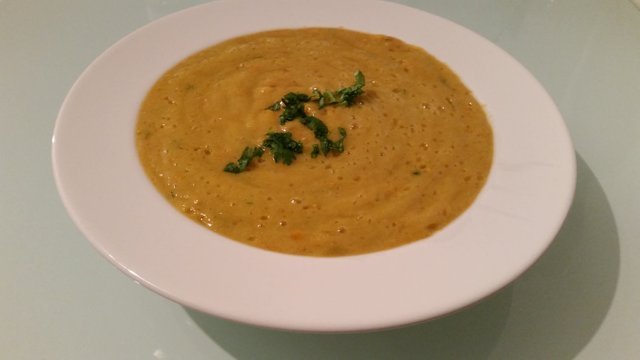
Blend until smooth:
500 g (≈1.1 lb) of "sweet" (only mildly sour) yellow or orange grape/cherry tomatoes, ideally without the stems (non-green tomatoes contain a very small amount of the glycoalkaloid tomatine, which, like the tomato lectin, seems to be relatively harmless - green tomatoes contain a lot more)
60 g (≈2.1 oz) of leek (which is a lot less problem-causing than onions but similar in taste)
110 g (≈3.9 oz) of pitted Medjool/Deglet Nour dates
a small peeled piece of ginger the size of around 2 peas (certain spices can make your farts smell)
a small peeled piece of turmeric
semi-optionally, a small seedless piece of red chili pepper that's half as big as the ginger piece (the capsaicin chili peppers contain is toxic)
optionally, 3-30 g (≈0.1-1.0 oz) of coconut meat (30 g may contain enough fat to make your farts smell a bit, and most of the fat found in coconut meat is saturated fat), or 6-45 g (≈0.2-1.6 oz) of avocado.
Then add to the blended part:
500 g (≈1.1 lb) more of the same tomatoes, halved or quartered; for more flavor and easier digestion, remove the seeds (which you can strain to make tomato juice)
1-2 tablespoons of finely chopped coriander (AKA cilantro).
"Fries"
"Cheese"
"Pizza"
"Meatball Sandwich"
"Taco Salad"
"Chocolate Mousse"
For more recipes:



"But where do you get your protein from?"
From fruits and vegetables:
Whole plant foods contain all essential amino acids, just not always in well-balanced amounts.
"And what about minerals like iron and calcium?"
Fruits and vegetables.
"Given how little thought is given to such considerations when we're chomping away at hamburgers and feasting on processed foods, fretting over meeting vitamin and mineral requirements after switching to a far more nutrient-dense diet is a bit absurd.
A diet of uncooked fruits, vegetables, and perhaps a few nuts and seeds will supply you with a wide range of nutrients that a SAD diet can't hope to match."
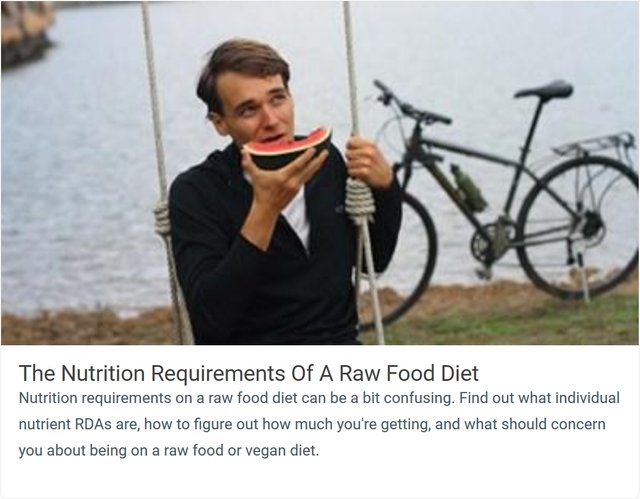
When you're pregnant/lactating, you may want to follow the American Thyroid Association's advice to take a daily iodine supplement of 150 mcg. That is, if you don't feel like eating, for example, sea vegetables, ≈23/47 extra bananas, or ≈27/54 extra plums on a daily basis.
As for vitamin D, sunbathing for around 5-30 minutes between 10:00 a.m. and 3:00 p.m. twice a week with your face, arms, legs, or back exposed could be enough to meet the National Academy of Medicine's recommended dietary allowance. The more skin is exposed, the more vitamin D is produced. The darker your skin, the more sunshine you need.
However, there's quite a lot of evidence suggesting that the academy's recommended dietary allowance should be much higher:
If you live far away from the equator, and your vitamin D reserves aren't big enough to last you through the winter, you can prevent becoming deficient with ultraviolet light-irradiated mushrooms, supplements, or UVB ray-focused tanning beds.
As healthy as a fruitarian diet may be, getting your blood checked every now and then is still a good idea.
Update
I just learned about the Sperti D/UV-Fluorescent lamp, about its competitors, and about UVB LEDs.
Tips & Tricks
1. Make sure to eat enough. I'm 1.88 meters tall (≈6'2"), and I eat at least 3000 calories a day.
2. Eat fruit when it's ripe. Ripe fruit is not only sweeter but also a lot easier to digest.
3. Stock up on dried or frozen fruit, since you may not always be able to get your hands on ripe fruit. Dates and frozen bananas are decent options (though I'm not sure frozen foods can really be considered raw).
As for date smoothies, a good date to water ratio is one part date to three parts water, weight-wise. Also, I suggest soaking your dates in water for an hour or more (unless your blender is really powerful).
4. A playlist about the buying and handling of bananas:

5. "Chew" your smoothies. Chewing produces saliva, and saliva contains ptyalin, an enzyme that breaks starch down into simple sugars. If your teeth are too damaged to come into contact with acidic or sugary foods, using a straw is fine, since ripe fruit generally contains very little starch, and since ptyalin can also do its job in the stomach...
6. You may want to use a vacuum blender instead of a regular one to make your smoothies.
Update
The vacuum function of my Glass Personal Vacuum Blender recently broke for a second time. The only other two vacuum blenders I know of that come with a glass container are the Klarstein Airakles vacuum blender and the Byzoo Vacuum Blender Giraffe.
Update
I recently realized that I'm not sure whether expanding in a vacuum affects food negatively. To be clear, though, I haven't come across any evidence that suggests vacuum blending really is harmful. In fact, I just read that human skin cells survive longer in a vacuum when you try to preserve them (much like various nutrients do). I think I've also read that vacuum blenders aren't even able to create a perfect vacuum. Nonetheless, I figured I should at least acknowledge that it may not be "natural" to put your food in a vacuum.
7. If you're suffering from digestive issues, replacing vegetables and acidic fruits with non-acidic fruits (like banana) or less-acidic fruits (like mango) can help.
8. Take care of your teeth!
I suggest brushing your teeth (and the rest of your mouth) after every meal with a soft toothbrush, especially after eating smoothies, and ideally before breakfast too. But, after eating acidic or sugary food, you want to wait 30-60 minutes before you do. Rinsing your mouth with water immediately after eating is also a good idea. And, when brushing your teeth isn't possible, eating some crisp, water-rich, less sugary food, like celery, cucumber, or carrot helps.
Update
I did some more research, including talking to my dentist, and now I'm thinking that, after eating something acidic or sugary, it may actually be best not to wait 30-60 minutes, but to immediately (and gently) brush your teeth, once you've rinsed your mouth with water a couple of times for 15 seconds.
It's my understanding that the water may raise your mouth's pH enough for you to be able to safely brush your teeth. Plus, in my experience, crisp fruits and vegetables, which are supposed to be good for your teeth, seem to be about as tough on them as a soft toothbrush, if not more. However, I'm not really an expert on teeth, so this should definitely be taken with a grain of salt.
9. Eating a fruitarian diet often leads to a bigger grocery bill, but:
11. Try not to annoy people into eating fruitarian or vegan. Over the nine years I've been vegan, I've come to learn that it's much more effective to simply lead by example.
12. Inform yourself about food addiction.
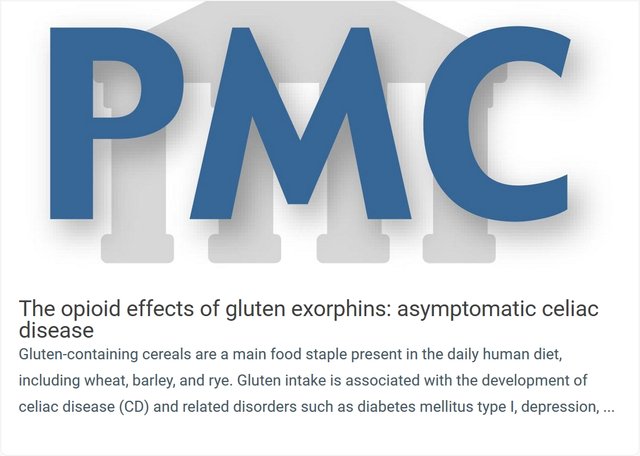
I've gone fruitarian numerous times now - overcoming my cooked-food addiction usually took me around 2-4 weeks. Fortunately, during those weeks, I only really craved cooked food whenever I started to get hungry.
I wouldn't underestimate the cravings, though. My brain literally tried to convince me that I'll never be happy again if I don't eat cooked food. Needless to say, it lied. So much so that, every time I started eating cooked food again, I had almost zero fun eating it the first few days.
Things that helped me through the withdrawals:
having a list of the reasons why I want to go fruitarian with me
reading and watching videos about the diet/lifestyle
keeping myself busy
distracting myself with, for example, exciting movies, shows, and video games
banana ice cream
fresh coconut water (because of its sodium content)
and "savory/salty" snacks, like peeled red bell peppers, "sweet" grape/cherry tomatoes, and almost-dry chopped-up tomatoes, especially in combination with avocado and leek/celery powder.
(At 102 degrees Fahrenheit/39 degrees Celsius, it takes around 12-16 hours for halved tomato quarters to become almost dry, and around 30 hours for small celery pieces to dry.)
Update
Depending on which dehydrator you use, the temperature can fluctuate significantly, so you may want to set the temperature a couple of degrees lower. Or, even better, use a thermometer that will alert you if the dehydrator gets too warm.
The only dehydrators I know of that aren't supposed to go over the set temperature are Tribest's Sedona dehydrators that come with a "raw mode." But, when it comes to the Sedona Express, I found multiple reviews claiming that, even in raw mode, it gets quite a bit warmer than the set temperature. I also read a review claiming that the nine-tray Samson "Silent" Dehydrator holds the temperature to the exact degree. However, DiscountJuicers.com's review of the new six-tray model doesn't seem to support that.

Great article, I will definitely start reading Tony's book
Downvoting a post can decrease pending rewards and make it less visible. Common reasons:
Submit
what a fantastic blog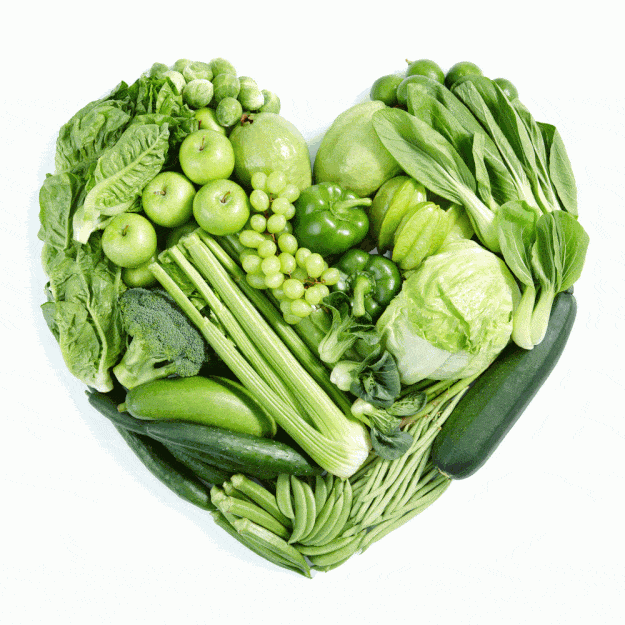
Downvoting a post can decrease pending rewards and make it less visible. Common reasons:
Submit
Thx!
Downvoting a post can decrease pending rewards and make it less visible. Common reasons:
Submit
(The article is basically an updated version of this article, which I published in June.)
Downvoting a post can decrease pending rewards and make it less visible. Common reasons:
Submit